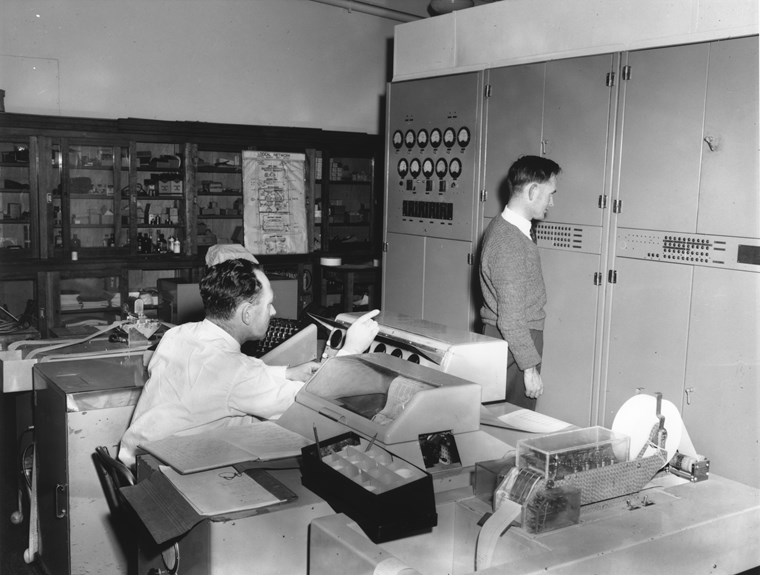Australia’s first computer finds new home at Scienceworks
CSIRAC is back! The world's longest surviving first-generation computer, and fourth computer in the world, opens to the public.
Scienceworks has welcomed one of the most important pieces of Australian innovation, CSIRAC (Commonwealth Scientific and Industrial Research Organisation Automatic Computer) to its ground-breaking Think Ahead exhibition in Melbourne's inner-west.
Acting General Manager of Scienceworks, Jonathan Shearer said that Scienceworks, Australia’s leading science and technology museum, is the perfect new residence for the iconic computer.
"CSIRAC is one of the most significant objects in Museums Victoria's collection of over 17 million items and has an important role to play in highlighting both the history and current state of computer technology, in Australia and internationally. CSIRAC’s story shows that Australia has a strong record of innovation in STEM and we hope the computer inspires a fascination in technology and science in our visitors of all ages."
Half the size of a shipping container and about a millionth of the speed, computing power, and volume of a smartphone, CSIRAC was at the cutting-edge of the new field of computing when it was built in 1949. CSIRAC is Australia’s first stored-memory computer, and the fourth in the world to ever be built.
Originally engineered at CSIRO in Sydney, CSIRAC was moved to the University of Melbourne in 1955. After taking a year to reassemble (a measure of the machine’s complexity!) it was ceremoniously switched on in 1956.
For the next eight years, CSIRAC provided a highly sought after computing service for science and industry. Demand for time using CSIRAC was so great, that people often had to wait weeks to gain access.
Operating for approximately 30,000 hours and tackling around 700 projects, it was used to play the first electronic music, make weather forecasts, calculate mortgages and even play some of the first computer games.
CSIRAC was large, energy-hungry and temperamental, particularly on hot days. Occasionally somebody would plug in an electric jug, overload the power system and all that day’s work would be lost. But engineers were consistently working to improve its storage and speed.
"This room-filling machine is the technological ancestor of your phone or laptop, but was nowhere near as powerful and definitely couldn’t fit in your pocket," explains Jonathan Shearer.
Pearcey Foundation member and former Head of the Department of Computer Science at the University of Melbourne, Dr Peter Thorne worked with CSIRAC as weekend computer technician in the early 1960s.
He said that to the Australian ICT sector, CSIRAC is a symbol of our nation’s sustained excellence in information and communications technology, from the very beginning of the computer age.
"A team of computing pioneers and volunteers has worked for decades to ensure that the history of CSIRAC is fully documented. As a result, CSIRAC is now recognised internationally: as the only survivor of the handful of machines that launched the modern digital age and as the first computer to play music."
"The Pearcey Foundation (named in honour of Trevor Pearcey who initiated the design of CSIRAC) is collaborating with Museums Victoria, CSIRO, Australian Computer Society, universities, and the computer industry, to ensure that CSIRAC, and our remarkable ICT heritage, has the widest possible exposure and that it continues to inspires our excellence in the ICT field."
CSIRAC has been in Museums Victoria’s collection since 1964 and was on display at Melbourne Museum from 2000 until 2017.
It has been relocated to the Think Ahead exhibition at Scienceworks which imagines how advances in science and technology will change the way we live in the future. It presents both historic and contemporary technology, as well as digital interactives.
CSIRAC will be part of the Communication section which features the history of computing and since opening has included reference to CSIRAC.
The display provides fascinating insight into the evolution of computing technology from machines that were half the size of shipping containers that computer programmers needed a fundamental understanding of the way the machinery worked to use, to portable lap tops and phones with clever software that negates the requirement to understand this.
It will also highlight how Australia is again at the forefront of computer innovation with Australian scientists, including 2018 Australian of the Year Michelle Simmons, working to build the world’s first quantum computer.
CSIRAC is now on permanent display in Think Ahead at Scienceworks.
Fun Facts
| CSIRAC | Lap top 2018 | |
|---|---|---|
| Processing Speed | 500–1000 hertz | 2.4 billion hertz |
| Memory Capacity | 2000 bytes | 16.5 billion bytes |
| Size | 40 square metres | 0.2 square metres |
| Weight | 2500 kg | 2kg |
| Power Consumption | 30,000 watts | 65 watts |
| Technology | 2000 valves | Micro electronic chips |
Interviews available with:
- Jonathan Shearer, General Manager of Scienceworks
- Dr Peter Thorne, former CSIRAC computer technician
For media enquiries, please contact:










